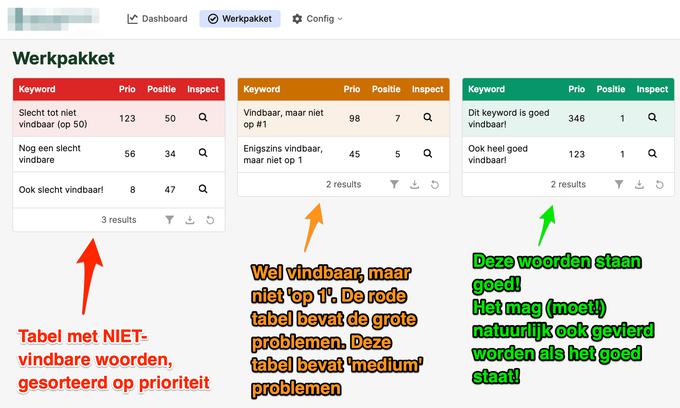A psychological mechanism that leads to
better content
and
satisfied visitors
Hygiene is essential for content. For trust, customer service, visitor decision-making, competitive edge, and SEO.
The problem #
How do you motivate innovative scrum-teams to not only look forward, but also look back? Back to things they (or former colleagues) created in the past? In a structural way?
The pressure is high to deliver and to show shiny new things; we understand.
The solution #
In our experience , it's possible to break through the said problem, because there are two things more important than 'new': results, and competitiveness (with other scrum teams).
So we created a way, a process along with corresponding tools, to identify on a website those pieces of content that are not clear, cause confusion, and go unnoticed, but are responsible for most issues.
This is particularly important for websites with a lot of existing content. The question is not: 'what content should we create,' but: 'which content is performing well, and which should we improve.' And why? With what priority?
The two levers: data and psychology #
Our tooling and procedure consists of two parts: data and psychology.
-
1.
Data: with data, we show where content problems lie, and which are larger than others. With data, we show the progress of activities. And, over time, we also show what it has all yielded.
-
2.
Healthy competition: we demonstrate the size and development of those content problems per team with numbers. With these numbers, you can go out internally: 'with this team, we have achieved success x: you want that too, right?
How it works #
Our tool doesn't automagically determine the solution needed for identified problems. That's too complex; it could be an organizational issue, a technical one, or just a small mistake.
However, human insight - and usually also coordination among team members - is required for that. We will handle that ourselves.
What the tool does though, is to indicate precisely:
-
1.
Which questions people ask
-
2.
Wether they find the answer, to what extent, and how
-
3.
-
4.
And we translate it into a hands-on work package
-
5.
Including progress reporting
Example 1. Issue overview #
The 'work package' is a visual overview, a list of identified problems, categorized by severity (ranging from very severe to mild) and the number of times that problem occurred. It is then grouped by responsibility and sorted by priority:
Example 1: Issues overview

Example 2. Todo-list #
There are multiple ways to configure the to-do lists and related monitoring, but the most important screen houses the 'mapping' table: an overview of search terms people have actually used. We map those to URLs we think houses the best answer to people's queries.
Mapping example

Example 3. Progress Report #
The progress report is deliberately simple. A target, a line indicating whether the target has been met:
Score & target example

From the moment the target has been achieved, you can switch from proactive to reactive, or, of course, set a new target!
What does "achieving the target" mean?
It means that a fundamental condition has been met, which is that people actually end up in the right place when they search for something. It used to be only 30%, but now it's 90%.
This difference will also be clearly noticeable in other measurements, such as conversion rates.
Most suitable for ... #
-
-
Large websites that have grown historically with a lot of content scattered throughout various parts and corners of the site.
-
-
Large websites with a search function and/or chatbot.
-
-
Websites where old content can be modified (this service is therefore not suitable for news websites).
So, especially websites that have too much content to have an immediate overview, and where different teams manage their own parts of the site.
Planning #
-
-
Setup & getting up to speed (ca. 4 months): We start with setting up the tool for your particular use-case. We also make sure that you are able to and confident in using it.
-
-
Execution (as long as necessary): after this there are several ways to proceed, depending on how much of the work is done internally within your own organisation, or by us.
We begin with a more intensive collaboration, gradually shifting more of the execution to your side. This is actually the ultimate goal.
Pricing #
Product & setup #
To get to know your website and market, to collect the needed data, and to tune the product specifically for your wishes, we charge a one-time setup fee.
Setup - Content Quality
€ 3077
Subscription fee #
For continuous usage of the product we use a subscription-based monthly or yearly fee.
Tip: if you use the yearly subscription, you receive two months for free!
Optional: Extra consultancy #
We always offer fair use support for any product.
But if needed, you can also call upon extra consultancy. Pricing is simple: varying wages, depending on the amount of hours required (during 12 months).
Of course, only the hours that are actually 'used' will be invoiced.
Consultancy, 120+ uur
€ 107
Consultancy, 60-120 uur
€ 127
Consultancy, 12-60 uur
€ 147
Consultancy, 4-12 uur
€ 167


